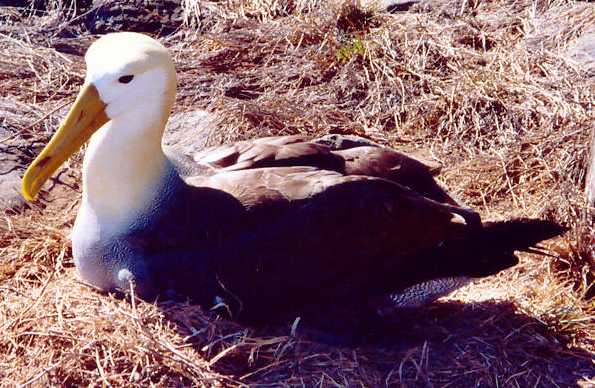|
| Query: Albatross | Result: 1st of 318 | |
Waved Albatross (Phoebastria irrorata) - Wiki
| Subject: | Waved Albatross (Phoebastria irrorata) - Wiki
| |

| Resolution: 595x388
File Size: 49902 Bytes
Upload Date: 2007:12:14 13:57:59
|
Waved Albatross
From Wikipedia, the free encyclopedia
Order: Procellariiformes
Family: Diomedeidae
Synonyms: Diomedea irrorata
[Photo] Waved Albatross (Phoebastria irrorata) nesting on the Galapagos island of Espa??ola (Hood). Author: Photograph by Robert J. Hall.
The Waved Albatross, Phoebastria irrorata - also known as Galapagos Albatross - is the only member of the Diomedeidae family located in the tropics. It breeds exclusively on Espa??ola Island in the Gal??pagos archipelago. When they forage, the Waved Albatross follow straight paths to a single site off the coast of Peru, about 1,000 km distant to the east. During the non-breeding season, these birds reside primarily in the areas of the Ecuador and Peruvian coasts.
These are medium-sized albatrosses, measuring about 86 cm (34 in) long, weighing in at 3.4 kg (7.5 lbs) and having a wingspan 2.27 m (7.5 ft). They are distinctive for their yellowish-cream neck and head, which contrasts with their mostly brownish bodies. Even more distinctive is the very long, bright yellow bill; which looks disportionately large in comparison to the relatively small head and long, slender neck.
The nests are built on areas of lava with boulders and sparse vegetation. The primary food sources of the Waved Albatross are fish, squid, and crustaceans. But they have also been observed to scavenge for other food sources, including the regurgitated food of other birds.
The population of Waved Albatrosses on the Gal??pagos is protected by national park personnel. But limited range, bycatch by long-line fishing, disturbance via tourism, disease, and the effects of illegal fishing in the nearby waters place them in considerable jeopardy. Especially long-line fishing seems to be making a severe impact in the species, which was uplisted to Vulnerable from Near Threateened by the IUCN in 2000. Despite some 34,700 adult birds still occurring in 2001, their numbers have apparently started to decrease at an unknown rate more recently, probably due to longline fishing which also upsets the sex ratio (males being killed more frequently). As the current situation makes the population highly vuknerable to a catastrophic collapse to extinction, it is uplisted to Critically Endangered status in the 2007 IUCN Red List.
http://en.wikipedia.org/wiki/Waved_Albatross
| The text in this page is based on the copyrighted Wikipedia article shown in above URL. It is used under the GNU Free Documentation License. You may redistribute it, verbatim or modified, providing that you comply with the terms of the GFDL. |
|
Comments |
|---|
| | Guest |
|
| Waved Albatross (Phoebastria irrorata) |
^o^
Animal Pictures Archive for smart phones
^o^
|
|
|